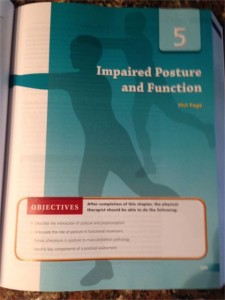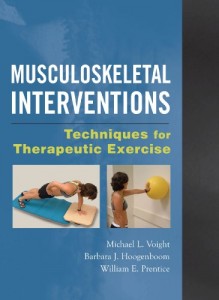Musculoskeletal Interventions: Techniques for Therapeutic Exercise (3rd Ed) Edited by Barbara J Hoogenboom, Michael L. Voight, and William E. Prentice.
![]()
 I was honored to be a contributor in this text, Chapter 5: Impaired Posture and Function. Though I may be a bit biased, I wanted to provide a review of this textbook to let others know how excellent it is.
I was honored to be a contributor in this text, Chapter 5: Impaired Posture and Function. Though I may be a bit biased, I wanted to provide a review of this textbook to let others know how excellent it is.
The editors of Musculoskeletal Interventions, Barb Hoogenboom, Mike Voight & Bill Prentice are leaders in the field of sports physical therapy. They’ve done a great job updating their previous edition, representing a paradigm shift in rehabilitation: functional movement. They stated, “The purpose of this text is to provide a comprehensive guide to assist practitioners in the design, implementation, and progression of rehabilitation programs for patients with musculoskeletal dysfunction.”
 The book meets its purpose through its organization and content, divided into 5 parts. In addition, “Clinical Pearls” are suggested throughout the text, providing helpful hints from seasoned clinicians. The textbook has great photos and graphics that are available to instructors who adopt the textbook.
The book meets its purpose through its organization and content, divided into 5 parts. In addition, “Clinical Pearls” are suggested throughout the text, providing helpful hints from seasoned clinicians. The textbook has great photos and graphics that are available to instructors who adopt the textbook.
Part 1 (Ch. 1-5) provides the foundation for rehabilitation progressions, including problem-solving, clinical decision-making, and the use of evidence-based practice, including a nice chapter on pain (and impaired posture, of course).
Part 2 (Ch. 6-9) provides updated information on treating physiological impairments including function, muscle performance, and neuromuscular function.
Part 3 (Ch 10-19) provides the “tools” of rehabilitation with chapters including different techniques such as Reactive Neuromuscular Training, Proprioceptive Neuromuscular Facilitation (PNF), and Open vs. Closed kinetic chain training. I particularly liked several chapters including Chapter 15, “Establishing Core Stability in Rehabilitation,” and Chapter 17, “Functional Movement Assessment.”
Chapter 19, “Functional Training and Advanced Rehabilitation,” was my favorite chapter. It begins by providing the neurological basis for functional movement.
The authors describe 4 principles of therapeutic exercise prescription:
- Functional evaluation
- Evaluation of motor control
- Osteo/arthrokinematic limitations
- Movement pattern assessment
The chapter also illustrates corrective exercises using developmental patterns such as rolling, kneeling, and bridging.
Part 4 (Ch. 20-28) discusses regional considerations by body part. Each chapter reviews pathomechanics and injury mechanisms focusing on rehabilitation strategies. Specific exercises and rehabilitation progressions are plentiful. Of note is Of note is Chapter 27, “Cervical and Thoracic Spine”, that reviews several pathologies and provides some great exercise examples.
Part 5 (Ch. 29-31) provides very relevant additions to this edition with chapters on special populations including geriatric, pediatric, and active females. Chapter 31 on “Conditions for Physically Active Females” is very comprehensive and includes detailed review of specific injuries and sport-specific considerations.
I have found that one of the weaknesses of some new graduates in physical therapy and athletic training is therapeutic exercise prescription and progression. As the editors suggest, this text helps improve “decision making in therapeutic intervention and rehabilitation progression.”
I highly recommend it as a “must-have” for those interested in musculoskeletal therapeutic exercise prescription and progression. The book is appropriate for both adoption in therapeutic exercise classes and for experienced professionals.
Click here to read reviews and purchase on Amazon.com